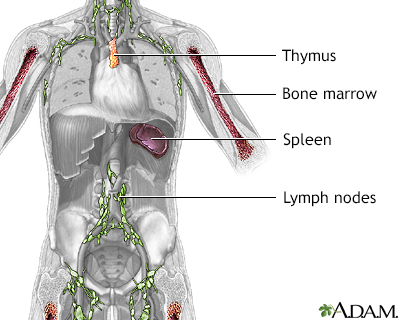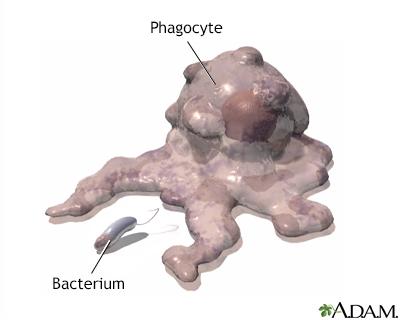Immune response
The immune response is how your body recognizes and defends itself against bacteria, viruses, and substances that appear foreign and harmful.
Information
The immune system protects the body from possibly harmful substances by recognizing and responding to antigens. Antigens are substances (usually proteins) on the surface of cells, viruses, fungi, or bacteria. Nonliving substances such as toxins, chemicals, drugs, and foreign particles (such as a splinter) can also be antigens. The immune system recognizes and destroys, or tries to destroy, substances that contain antigens.
Antigens
An antigen is any substance that causes your immune system to produce antibodies against it. This means your immune system does not recognize the su...

Toxins
Toxins are substances created by plants and animals that are poisonous (toxic) to humans. Toxins may also include some medicines that are helpful in...

Your body's cells have proteins that are antigens. These include a group of antigens called HLA antigens. Your immune system learns to see these antigens as normal and usually does not react against them.
HLA antigens
A histocompatibility antigen blood test looks at proteins called human leukocyte antigens (HLAs). These are found on the surface of almost all cells...

INNATE IMMUNITY
Innate, or nonspecific, immunity is the defense system with which you were born. It protects you against all antigens. Innate immunity involves barriers that keep harmful materials from entering your body. These barriers form the first line of defense in the immune response. Examples of innate immunity include:
-
Cough reflex
Cough
Coughing is an important way to keep your throat and airways clear. But too much coughing may mean you have a disease or disorder. Some coughs are d...
 ImageRead Article Now Book Mark Article
ImageRead Article Now Book Mark Article - Enzymes in tears and skin oils
- Mucus, which traps bacteria and small particles
- Skin
- Stomach acid
Innate immunity also comes in a protein chemical form, called innate humoral immunity. Examples include the body's complement system and substances called interferon and interleukin-1 (which causes fever).
If an antigen gets past these barriers, it is attacked and destroyed by other parts of the immune system.
ACQUIRED IMMUNITY
Acquired immunity is immunity that develops with exposure to various antigens. Your immune system builds a defense against that specific antigen.
PASSIVE IMMUNITY
Passive immunity is due to antibodies that are produced in a body other than your own. Infants have passive immunity because they are born with antibodies that are transferred through the placenta from their mother. These antibodies disappear between ages 6 and 12 months.
Antibodies
An antibody is a protein produced by the body's immune system when it detects harmful substances, called antigens. Examples of antigens include micr...

Passive immunization may also be due to injection of antiserum, which contains antibodies that are formed by another person or animal. It provides immediate protection against an antigen, but does not provide long-lasting protection. Immune serum globulin (given for hepatitis exposure) and tetanus antitoxin are examples of passive immunization.
Tetanus
Tetanus is an infection of the nervous system with a type of bacteria that is potentially deadly, called Clostridium tetani (C tetani).

BLOOD COMPONENTS
The immune system includes certain types of white blood cells. It also includes chemicals and proteins in the blood, such as antibodies, complement proteins, and interferon. Some of these directly attack foreign substances in the body, and others work together to help the immune system cells.
Lymphocytes are a type of white blood cell. There are B and T type lymphocytes.
- B lymphocytes become cells that produce antibodies. Antibodies attach to a specific antigen and make it easier for the immune cells to destroy the antigen.
- T lymphocytes attack antigens directly and help control the immune response. They also release chemicals, known as cytokines, which control the entire immune response.
As lymphocytes develop, they normally learn to tell the difference between your own body tissues and substances that are not normally found in your body. Once B cells and T cells are formed, a few of those cells will multiply and provide "memory" for your immune system. This allows your immune system to respond faster and more efficiently the next time you are exposed to the same antigen. In many cases, it will prevent you from getting sick. For example, a person who has had chickenpox or has been immunized against chickenpox is immune from getting chickenpox again.
Immune response - Animation
Special white blood cells called lymphocytes play a key role in the immune system's response to foreign invaders. There are two main groups, both of which form in bone marrow. One group, called T-lymphocytes or T-cells, migrates to a gland called the thymus. Influenced by hormones, they mature there into several types of cells, including helper, killer, and suppressor cells. These different types work together to attack foreign invaders. They provide what's called cell-mediated immunity, which can become deficient in persons with HIV, the virus that causes AIDS. HIV attacks and destroys helper T cells. The other group of lymphocytes are called B-lymphocytes or B cells. They mature in the bone marrow and gain the ability to recognize specific foreign invaders. Mature B cells migrate through the body fluids to the lymph nodes, spleen, and blood. In Latin, body fluids were known as humors. So B-cells provide what's known as humoral immunity. B-cells and T-cells both circulate freely in blood and lymph, searching for foreign invaders.
INFLAMMATION
The inflammatory response (inflammation) occurs when tissues are injured by bacteria, trauma, toxins, heat, or any other cause. The damaged cells release chemicals including histamine, bradykinin, and prostaglandins. These chemicals cause blood vessels to leak fluid into the tissues, causing swelling. This helps isolate the foreign substance from further contact with body tissues.
Swelling
Swelling is the enlargement of organs, skin, or other body parts. It is caused by a buildup of fluid in the tissues. The extra fluid can lead to a ...

The chemicals also attract white blood cells called phagocytes that "eat" germs and dead or damaged cells. This process is called phagocytosis. Phagocytes eventually die. Pus is formed from a collection of dead tissue, dead bacteria, and live and dead phagocytes.
Phagocytosis - Animation
These amoeba-like cells are a type of phagocyte called macrophages. They're scavenger cells that can form tentacles called pseudopods to surround and ingest foreign cells. Once swallowed, the cells are walled off and destroyed by a bag of digestive enzymes.
IMMUNE SYSTEM DISORDERS AND ALLERGIES
Immune system disorders occur when the immune response is directed against body tissue, is excessive, or is lacking. Allergies involve an immune response to a substance that most people's bodies perceive as harmless.
Allergies
An allergy is an immune response or reaction to substances that are usually not harmful.

IMMUNIZATION
Vaccination (immunization) is a way to trigger the immune response. Small doses of an antigen, such as dead or weakened live viruses, are given to activate immune system "memory" (activated B cells and sensitized T cells). Memory allows your body to react quickly and efficiently to future exposures.
Immunization
Vaccines are used to boost your immune system and prevent the risk of infection and the severity of infections, including those that cause serious, l...

Vaccines - Animation
Ouch! Vaccines help to give the body immunity from infections. Different vaccines work in different ways. Some vaccines inject fragments of a virus or bacteria called antigens into the body. Once in the blood, these antigens circulate among the blood cells, which include red blood cells and white blood cells. White blood cells, such as B and T cells, help fend off foreign invaders. When antigens invade tissue, they attract macrophages. These are scavenger cells that engulf the antigens. The macrophages then signal to T-cells that the antigens are invading. Killer T cells gather and attack the antigens. Then suppressor T cells stop the attack. After the vaccination, B-cells make defensive antibodies against the antigen. These antibodies help the cells remember this particular antigen, so that they can fight it off if the body is infected again.
COMPLICATIONS DUE TO AN ALTERED IMMUNE RESPONSE
An efficient immune response protects against many diseases and disorders. An inefficient immune response allows diseases to develop. Too much, too little, or the wrong immune response causes immune system disorders. An overactive immune response can lead to the development of autoimmune diseases, in which antibodies form against the body's own tissues.
Autoimmune diseases
An autoimmune disorder occurs when the body's immune system attacks and destroys healthy body tissue by mistake. There are more than 80 autoimmune d...

Complications from altered immune responses include:
- Allergy or hypersensitivity
-
Anaphylaxis, a life-threatening allergic reaction
Anaphylaxis
Anaphylaxis is a life-threatening type of allergic reaction.
 ImageRead Article Now Book Mark Article
ImageRead Article Now Book Mark Article - Autoimmune disorders
-
Graft versus host disease, a complication of a bone marrow transplant
Graft versus host disease
Graft-versus-host disease (GVHD) is a life-threatening complication that can occur after certain stem cell or bone marrow transplants.
 ImageRead Article Now Book Mark Article
ImageRead Article Now Book Mark Article - Immunodeficiency disorders
-
Serum sickness
Serum sickness
Serum sickness is a reaction that is similar to an allergy. The immune system reacts to medicines that contain proteins used to treat immune conditi...
 ImageRead Article Now Book Mark Article
ImageRead Article Now Book Mark Article - Transplant rejection
Reviewed By
Stuart I. Henochowicz, MD, FACP, Clinical Professor of Medicine, Division of Allergy, Immunology, and Rheumatology, Georgetown University Medical School, Washington, DC. Also reviewed by David Zieve, MD, MHA, Medical Director, Brenda Conaway, Editorial Director, and the A.D.A.M. Editorial team.
Abbas AK, Lichtman AH, Pillai S. Properties and overview of immune responses. In: Abbas AK, Lichtman AH, Pillai S, eds. Cellular and Molecular Immunology. 10th ed. Philadelphia, PA: Elsevier; 2022:chap 1.
Bankova L, Barrett N. Innate immunity. In: Burks AW, Holgate ST, O'Hehir RE, et al, eds. Middleton's Allergy: Principles and Practice. 9th ed. Philadelphia, PA: Elsevier; 2020:chap 1.
Firestein GS, Stanford SM. Mechanisms of inflammation and tissue repair. In: Goldman L, Schafer AI, eds. Goldman-Cecil Medicine. 26th ed. Philadelphia, PA: Elsevier; 2020:chap 42.
Tuano KS, Chinen J. Adaptive immunity. In: Burks AW, Holgate ST, O'Hehir RE, et al, eds. Middleton's Allergy: Principles and Practice. 9th ed. Philadelphia, PA: Elsevier; 2020:chap 2.
Disclaimer






 All rights reserved.
All rights reserved.